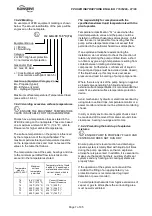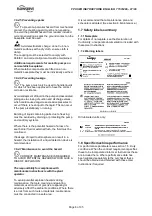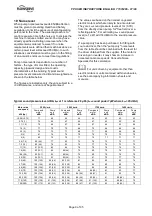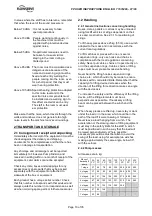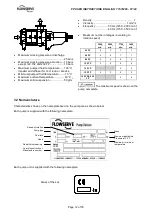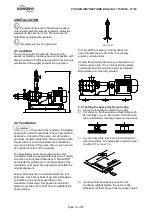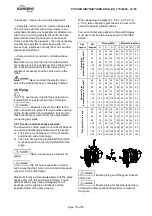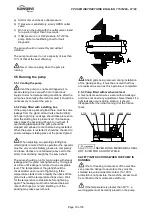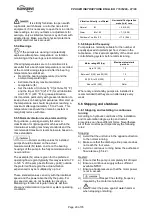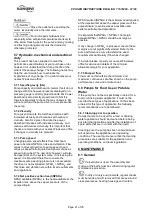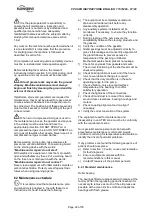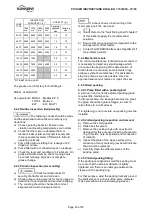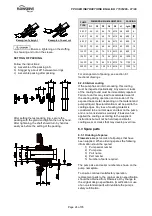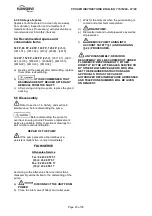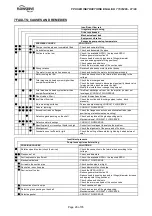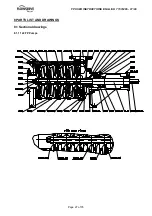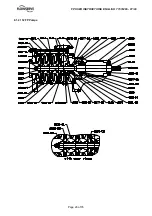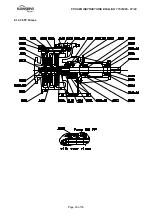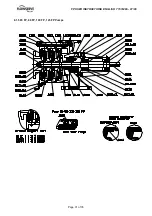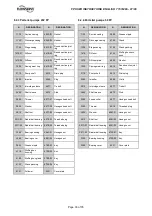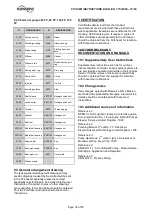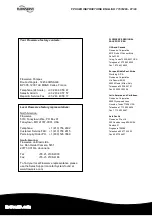
FP USER INSTRUCTIONS ENGLISH 71576286 - 07/06
Page 21 of 35
Shutdown:
Close the outlet valve and stop the
motor. Eventually close the inlet valve.
For prolonged shutdowns and
especially when ambient temperatures are likely to
drop below freezing point, the pump and any cooling
and flushing arrangements must be drained or
otherwise protected.
5.7 Hydraulic, mechanical and electrical
duty
This product has been supplied to meet the
performance specifications of your purchase order,
however it is understood that during the life of the
product these may change. The following notes may
help the user decide how to evaluate the
implications of any change. If in doubt contact your
nearest Flowserve office.
5.7.1 Specific gravity (SG)
Pump capacity and total head in meters (feet) do not
change with SG, however pressure displayed on a
pressure gauge is directly proportional to SG. Power
absorbed is also directly proportional to SG. It is
therefore important to check that any change in SG
will not overload the pump driver or over-pressurize
the pump.
5.7.2 Viscosity
For a given flow rate the total head reduces with
increased viscosity and increases with reduced
viscosity. Also for a given flow rate the power
absorbed increases with increased viscosity, and
reduces with reduced viscosity. It is important that
checks are made with your nearest Flowserve office
if changes in viscosity are planned.
5.7.3 Pump speed
Changing pump speed effects flow, total head,
power absorbed, NPSH
R
, noise and vibration. Flow
varies in direct proportion to pump speed, head
varies as speed ratio squared and power varies as
speed ratio cubed. The new duty, however, will also
be dependent on the system curve. If increasing the
speed, it is important therefore to ensure the
maximum pump working pressure is not exceeded,
the driver is not overloaded, NPSH
A
> NPSH
R
, and
that noise and vibration are within local requirements
and regulations.
5.7.4 Net positive suction head (NPSH
A
)
NPSH available (NPSH
A
) is the head available at the
impeller inlet, above the vapour pressure of the
pumped liquid.
NPSH required (NPSH
R
) is the minimum head required
at the impeller inlet, above the vapour pressure of the
pumped liquid, to avoid excessive cavitation and
extreme performance degradation.
It is important that NPSH
A
> NPSH
R
. The margin
between NPSH
A
> NPSH
R
should be as large as
possible.
If any change in NPSH
A
is proposed, ensure these
margins are not significantly eroded. Refer to the
pump performance curve to determine exact
requirements particularly if flow has changed.
If in doubt please consult your nearest Flowserve
office for advice and details of the minimum
allowable margin for your application.
5.7.5 Pumped flow
Flow must not fall outside the minimum and
maximum continuous safe flow shown on the pump
performance curve and or data sheet.
5.8 Pumps for Food Use or Potable
Water
If the pump has not been specifically ordered for a
food or drinking water application it must not be
used for these types of applications. If it has been
ordered for this type of application the following
recommendations are to be followed.
5.8.1 Cleaning prior to operation
Pumps that are to be used for a food or drinking
water application should be cleaned before being
put into initial operation and after the installation of
spare parts that are in contact with the liquid.
Cleaning once the pump has been commissioned
will depend on the application and operating
conditions. The user must ensure that the cleaning
procedures are suitable for the application and
operating conditions, and local regulations.
6 MAINTENANCE
6.1 General
If a belt drive is used, the assembly and
tension of the belts must be verified during regular
maintenance procedure.
In dirty or dusty environments, regular checks
must be made and dirt removed from areas around
close clearances, bearing housings and motors.

